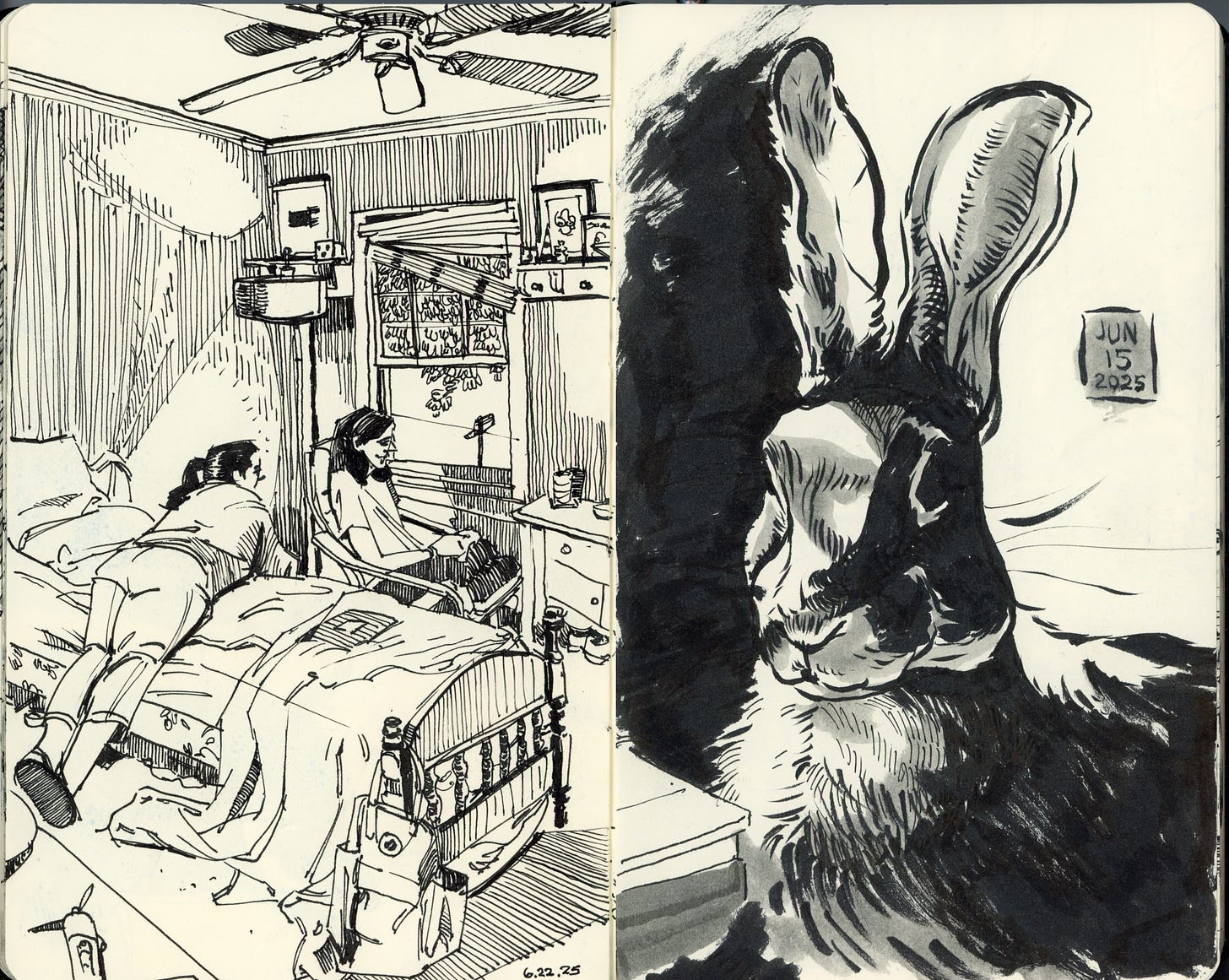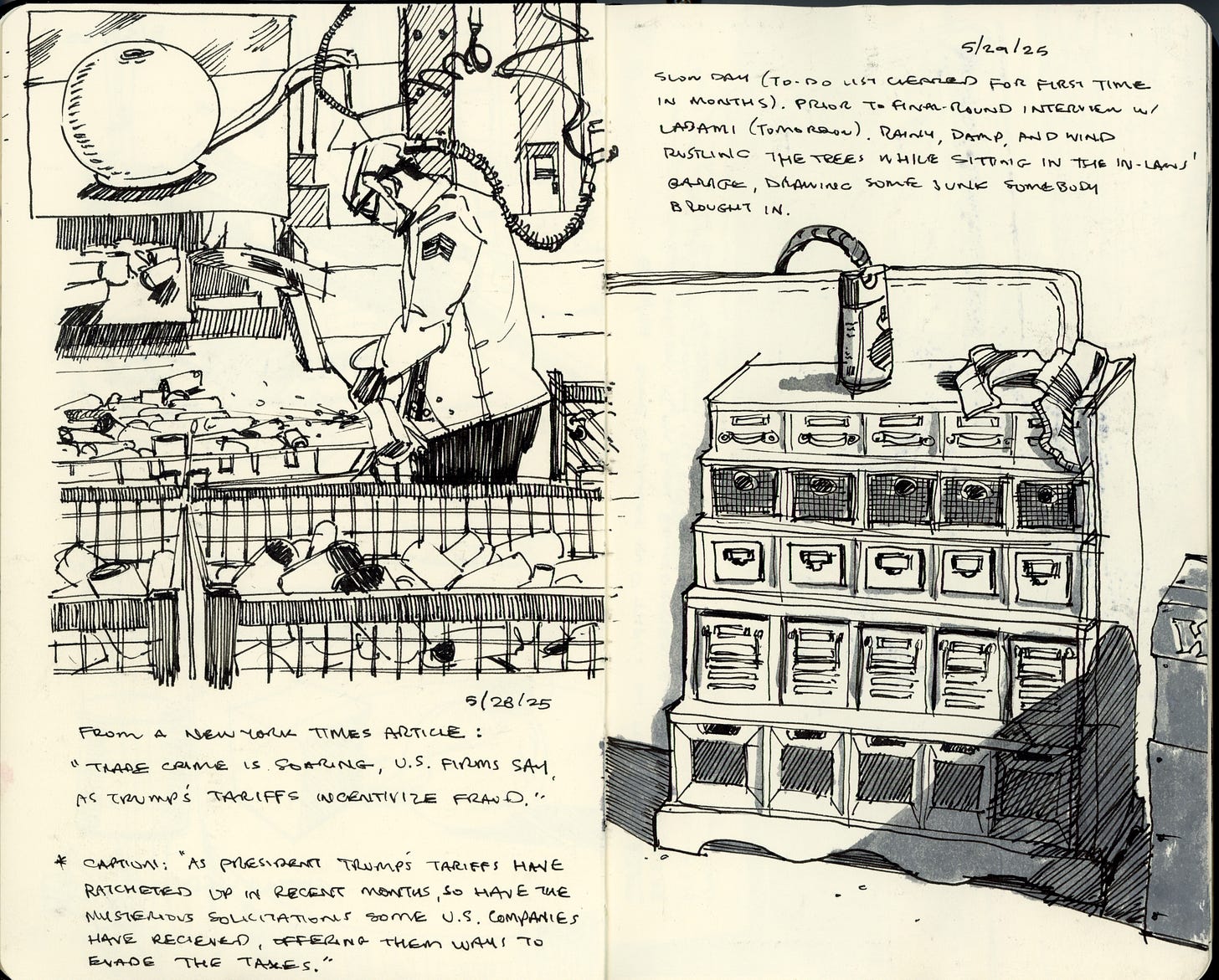A Wobbly Line is a Treasure
In the Age of AI, imperfection might be the most human thing we have
Hello friends,
Lately I’ve been spending a lot of my drawing time in a small sketchbook I’ve designated for one thing only: direct drawing. That is, drawing straight with ink, from observation, with no underdrawing, no erasing, and no edits. It’s become a practice I’m learning a lot from, and even starting to love.
Sketchbook Peek

A few recent pages from my “direct drawing” sketchbook—fountain or brush pen only, mostly drawn from life (also a couple from photos or news articles, and one from imagination).
What Drawing Directly in Ink Is Teaching Me
Learning to Think Before I Draw
Each mark, ideally, has to count for something. Once ink hits the paper, there’s no erasing. While that seemed a bit scary at first, it also felt thrilling- and honestly, very freeing.
Not being able to trade one line out for something “better” forces more confidence. It also teaches you to work with what you’ve got. Mistakes become incorporated into the whole. And it’s surprising how much you can get away with- the human eye values the truth of overall proportion and composition far more than it cares about a small detail or two out of place.
Learning to Be Less Precious
When I’m in my “direct-drawing-only” sketchbook, I have to let go of fear. I know I’m going to make a lot of mistakes. Jared Cullum- one of several artists who’ve inspired me to draw this way- likens it to fishing. It’s not about the catch, but the act of casting. Once in a while, you might land something really good. Most of the time, the point is to be engaged in observation while putting in as much mileage as you can. No one even needs to see this sketchbook but you - “algorithmic pressure”, as I like to call it, is as unnecessary as you’d like it to be.
The goal is to develop hand/eye dexterity while becoming more connected to the world around you. That said, I guarantee that if you try doing this for any length of time, you’ll end up with some drawings you quite like. Another analogy is shooting a roll of analog film. Among photographers, what they call a “keeper rate” is an expected percentage of photos worth keeping from a roll or shoot. With analog photography, it was often expected for this number to be quite low. So what did you do to increase the number of keepers? You just shot more film. My belief right now, and a big part of what I’m chasing, is that, if you want to learn how to draw intuitively, the same principle applies. Do not expect your first drawing to be good. Or your second, or third. This requires you to really love the process of drawing - because otherwise, why would you even do this to yourself? The trick is to so enjoy the act of drawing that you really do look forward to doing it all the time.
For me, that has meant getting rid of a lot of laborious and perfectionistic techniques and tendencies, and though I’m still journeying down this path, I can confirm that I’m having a lot more fun.
I want to be clear here and note that the drawings above are some of my “keepers”, and don’t reflect the level I always draw at, which can at times be much worse – but that’s my point! When you focus on drawing a lot rather than drawing perfectly, you will inevitably end up with some spontaneous drawings that you do like, and these drawings will be surprising and delightful in unexpected ways.
A New Way of Thinking
Line has its own language.
I’m more used to thinking in mass or tone. Most of my graphite drawings depend almost entirely on large swaths of graphic tone to achieve the kind of design I aim for. But with nothing but line to work with, you’re encouraged to solve problems creatively in new ways:
How do you draw a tree without defining every leaf?
How do you create light and shadow without relying on mass?
How do you suggest structure without overstating it?
It’s not a practice that’s an end in itself for me (though it could be!). What I love is the simplicity of it: just a single pen, a small sketchbook, and the ability to draw anywhere. So far, this has been the most direct and instantly accessible engagement with artmaking I’ve experienced. It isn’t my only practice, or even my main one, but I’ve already got the sense I’ll be doing it a long time, as it teaches me so many things I can take back into my painting and drawing when it’s not “direct.”
It’s Not That Scary
Here’s the cool thing-I’m only about a fourth of the way through my first “direct drawing” sketchbook, and I’m starting to forget that I can’t erase. I’m just solving problems differently. I’m also accepting the rough parts as par for the course.
And honestly, in the age of AI, who cares about perfection in drawing anyway?
I’d wager that in the future, a wobbly line will come at a premium.
👋 Until Next Time
Let me know-have you tried drawing directly with ink? What was the hardest part? What surprised you?
Do hit reply, I’d love to hear from you.
Until next month!🐊
Kevin







So much talent!